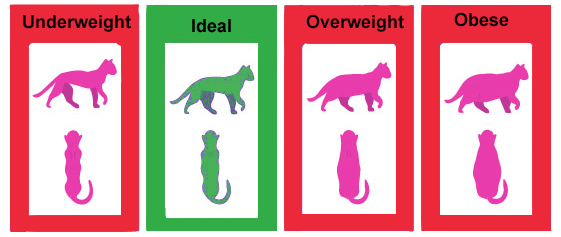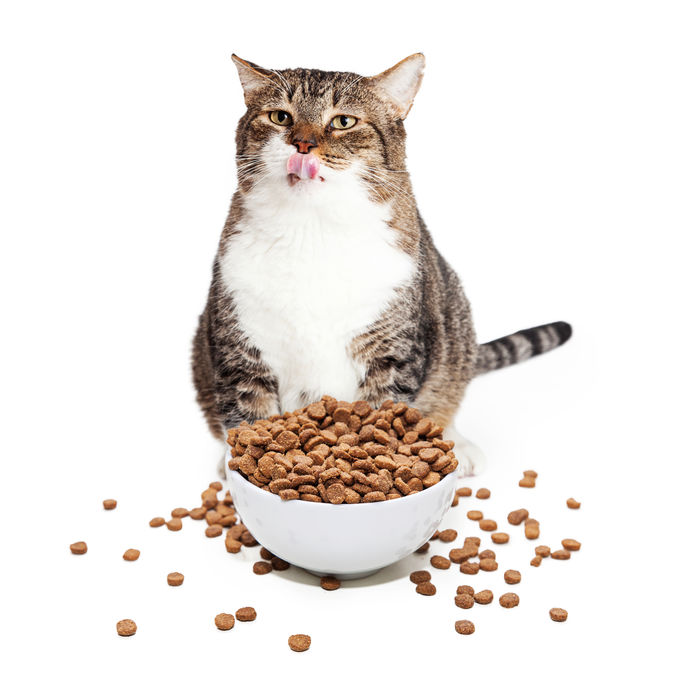Is your cat overweight?
Does it look as if your cat has a very, very thick winter coat? Maybe they’re looking just a wee bit too well padded? A recent survey of Australian vet practices found that around 32% of cats are overweight.
Why cat weight matters
Although those extra kilos may seem cute and cuddly, obesity is a real problem for some cats and may lead to issues such as joint problems and diabetes, which will reduce their quality of life, make them less active and shorten their life span.
How much should my cat weigh?
Healthy cats come in all shapes and sizes, and there’s no single “right” weight. Cat weight varies greatly depending on the breed and body type, but the average domestic short-haired cat should be around 3.5 to 4.5 kg. However, certain larger breeds, like Maine Coons, can weigh as much as 11 kg and smaller breeds can weigh as little as 2.2 kg.
How to spot an overweight cat?
Because we see them every day it’s difficult to notice changes in our cats’ weight and determining if your cat is overweight isn’t as simple as popping them on your bathroom scales. Take a look at our cat weight chart below for a clearer picture.
The quickest way to assess whether your cat is overweight is through a visual assessment and some basic physical examinations.
Take a look at your cat from above
When you look at you cat from above, you should be able to see a noticeable “waist” between your cat’s rib cage and hips. The shape of the rib cage should be obvious, but the ribs themselves should not be visible. If you cat is underweight, that ‘tuck’ will be more pronounced. In cats carrying too much weight, the waist is barely visible or is bulging out beyond the line of the ribs, and the shape of the rib cage may not even be visible.
Look from the side
At their ideal weight, a cat should have a distinct, gradual ‘tuck’ as the line of their rib cage flows up into their abdomen. A lean cat should slope upwards from the ribcage to the back legs, rather than sporting a tummy pouch. Older cats may be prone to having a little “sag” in their stomach region, but this should be somewhat distinguishable from a round tummy.
Give your cat a very gentle squeeze
Feel your cat’s torso and around the back end of their rib cage. You should be able to make out the spine and the outline of their last few ribs clearly. Don’t press too hard. If your pet is underweight, the ribs will feel very obvious. If they are carrying more weight than is good for them, it will be hard to feel individual ribs. If you are unable to feel any ribs through a thick layer of fat, then your pet is dangerously overweight.
From head to tail
Using only the lightest touch, run your fingers along the spine of your cat. At a healthy weight, you will be able to feel individual vertebrae under the skin, but if your pet is underweight, those vertebrae will feel sharp and bony. If you feel fat covering the bones your pet is overweight, and if they are extremely obese, you may not even be able to feel any individual vertebrae at all.Tips to help your cat lose weight
Just like their human counterparts, cats typically get fat because they eat too much and exercise too little. If your fur baby appears to be above the average cat weight, don’t panic too much. You can help your cat slim back down to a healthy weight, so they can get back to feeling their best.
1. No table scraps
Keep your cat at a distance when you’re eating, so you’re not tempted to feed them from your plate. Your cat does not need the extra calories.
2. Smaller meals
Give your cat multiple small meals so they can’t binge eat their food. Many cats only eat until they are full, but if they are allowed to consume more they may begin to eat past this point and gain weight.
3. No snacks or treats
While treats are a fun way to provide positive encouragement for your cat, they contain more calories than cat food and can add up quickly.
4. Plenty of attention
Some cats turn to eating when they are bored. Giving your cat some extra attention, especially with increased play time, is good for both their mind and body.

If your cat is having trouble losing weight
If the above tactics don’t produce results within a month or two, schedule a visit to the vet. Your local vet or vet nurse may talk to you about putting them on an integrated weight management program that combines a mixture of diet, lifestyle and activity changes or test for an underlying medical problem, such as hypothyroidism.
Spotting an overweight cat
Quick summary:
Based on our cat weight chart, how does your cat compare?
- When you run your fingertips along your cat’s side, can you feel their ribs?
- Is their spine noticeable?
- Can you feel their shoulder bones?
- If you stand above your cat and look down, is your cat’s waistline detectable as a slight indentation just behind the ribs?
If your answer to these questions is yes, your cat is likely at a healthy weight. If the ribs, spine and shoulder bones are overly visible however, there is a chance your cat is underweight.
- Does your moggy have a swinging pouch between their hind legs?
- Is your cat’s anal area a bit grubby? Some obese cats have trouble grooming this area.
- Is there a greasy patch, matting of fur, or flaking of skin down the midline of your cat’s lower back? The inability to reach this area when grooming can also indicate obesity.
- Does your cat snore or wheeze?
If you struggle to feel your cat’s bones or can detect a layer of fat above them, or you answered yes to the above questions, your cat may be overweight or obese and things need to change.
Cat care and nutrition
We feed balanced, nutritious pet food to the cats at our boarding kennels. To ask about our animals’ diets call 09 299 7415 or email us with your cat nutrition questions.
Cats under our care at our cattery are fed Royal Canin Fit. Every morning we check on the consumption of food and water to monitor their dietary maintenance closely, and we also monitor urinary and bowel motions.
We are happy to give your cat their own special cat food when provided. Every morning we check the consumption of food and water for close dietary maintenance. We also monitor urinary and bowel motions. We have a 24-hour vet on call, for any eventuality.
If you’re looking for a comfortable, safe and secure environment for your cat where you know your cat will be well looked after, call 09 299 7415 to ask about the benefits of a cattery. Inspections are welcome between 10.00am and 4.00pm each day.
